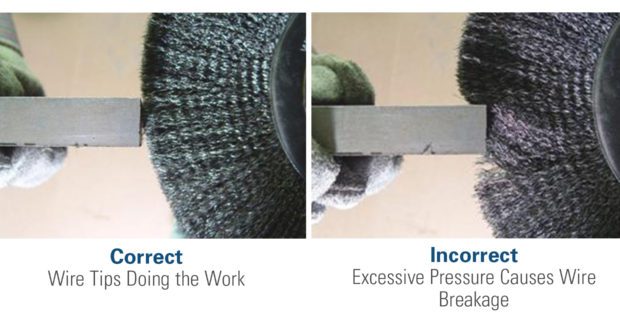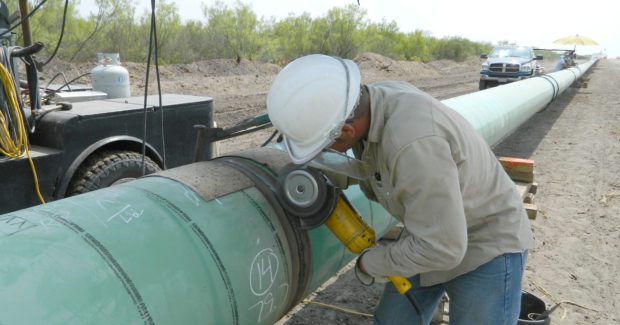Tips for Preventing Long Wire Breakage When Using Power Brushes
Typically caused by improper brush use or using the wrong brush for the application, long wire breakage does not fall under normal brush wear. It can be a costly problem that also poses safety hazards for operators and other workers in the area. Here are some ways to help prevent this issue so that you can get longer life and optimal performance from your power brushes.
Posted: December 19, 2016
Power brushes offer numerous benefits in surface conditioning, including the ability to clean and prepare a surface for welding without removing base material. When surface conditioning with power brushes, normal use and working conditions over time will cause the brush to wear as it breaks down. As part of this normal use, very small pieces of the wire tips often break off. However, long wire breakage is a different issue. Long wire breakage does not fall under normal brush wear, and it can be a costly problem that also poses safety hazards for operators and other workers in the area. Pieces of wire up to 1 in long can break off and become flying particles during use. Because long wire breakage is typically caused by improper brush use or using the wrong brush for the application, it’s important to consider some key best practices to help prevent this issue so that you can get longer life and optimal performance from your power brushes.
SPEED IS KEY
Preventing long wire breakage starts with using the correct speed, and that starts with choosing the right product with the appropriate rpm rating for the tool. The maximum rpm rating of the brush (which is typically marked on the product) should not be exceeded. Grinders also have rpm ratings; the rpm rating of the brush must meet or exceed the rating of the tool for safe and proper usage. If you are using a 4½ in right angle grinder that is rated at 10,000 rpm, for example, the brush must be rated for at least 10,000 rpm. Never exceed the maximum rpm of a power brush. In cases where the rpm of the tool or the brush is not known or cannot be read, it is unsafe to try to match the brush and tool simply by appearance only. It’s critical to remember that even though a brush may fit on a certain tool, that doesn’t mean it was designed for safe use on that tool.
WATCH THE PRESSURE AND ORIENTATION
With power brushes, the sharp wire tips are designed to do the work. For this reason, it is important to apply the proper pressure when using the brush. Always hold the brush at the correct angle to the workpiece, which is referred to as orientation. When the wire tips aren’t striking the workpiece as designed, it takes longer to get the job done, impacting operator efficiency and fatigue, and it can also shorten product life. Applying too much pressure is a common mistake when using power brushes in surface conditioning – one that can lead to long wire breakage. In cases where the wrong brush style is being used for the job, or when the right brush is being used at the wrong speed, an operator often applies too much pressure in an effort to get the necessary cleaning performance.
Too much pressure results in the wires of the brush bending, causing the sides of the wire to strike the base material instead of the sharp wire tips. This scenario creates stress on the wires that can cause long wire breakage, in addition to making the brush less effective and causing the operator to work harder than necessary to do the job. When using the correct brush for the job at the right speed, appropriate pressure typically involves using only the weight of the tool, without leaning or pushing down. Brush orientation is another important factor when surface conditioning with wire brushes. As previously stated, it’s important that the wires not bend or flex, in order for the tips to do the work. For optimal performance and safety, hold the brush perpendicular to the work surface, which also reduces the chances of long wire breakage. Proper orientation also helps prevent the operator from pushing too hard on the brush.
TIME’S UP
Once you’ve selected the right type of brush and are following the tips for using it correctly for the application, it’s also important to keep an eye on the brush condition. Just as with many products, wire brushes wear down over time and should not be used past their useful life. While the wires of a power brush are designed to flex, all that flexing over time causes points of wear and stress where the wires can eventually break. There is no hard and fast rule about how long a brush can be used before it should be replaced. You should regularly inspect the brush and watch for wear and damage. When a brush shows signs of long wire breakage, discontinue use of that particular brush. In addition to proper usage, proper storage in a clean, dry space can help extend brush life.
FOLLOW BEST PRACTICES
Best practices when using wire brushes should always include using personal protective equipment and the protective guards for the tool. Follow the manufacturer’s recommendations for usage and read all safety information. Surface preparation and cleaning are key parts of many welding applications. Choosing the appropriate brush for the job – and following best practices for its proper use – can help operators get the job done efficiently and safely for optimal results.






